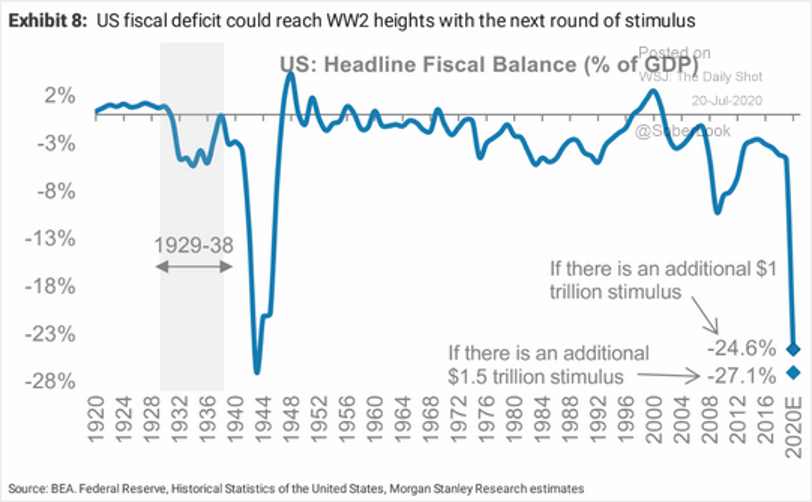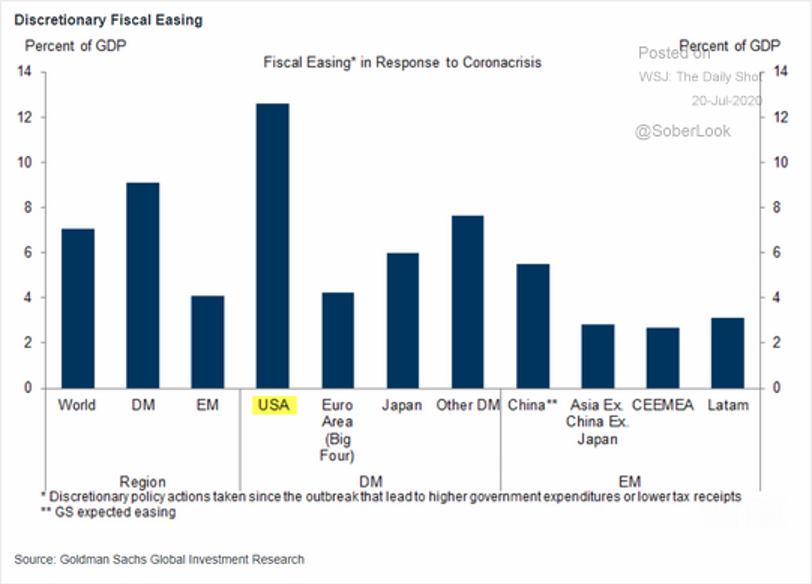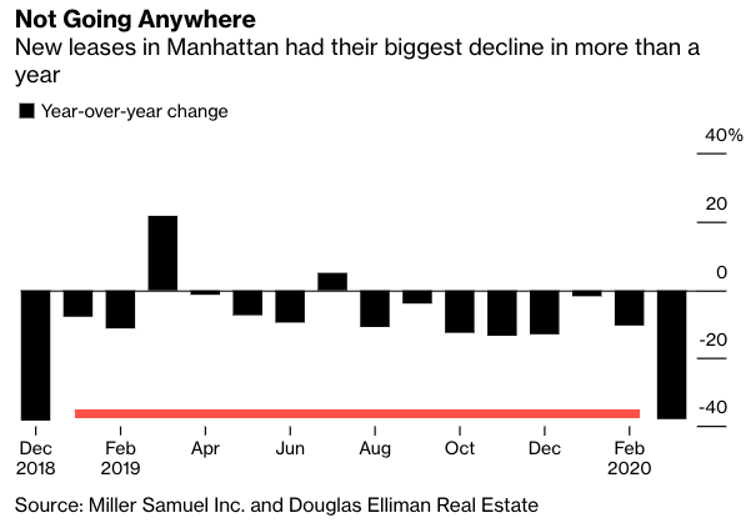1. Interest Rates Have Been Trending Down on “Real” Basis for 800 Years.
On Inflation adjusted basis rates have been in forever trend downward.
The monetary standard has no influence on the trend-To get a better feel for the the shape of interest rates over time, below is another chart from Schmelzing’s paper.

Global real interest rate from 1317 to 2018, GDP-weighted. This includes both marketable and non-marketable debts (Source: Schmelzing, 2020) Eight centuries of interest rates.
2. Have Emerging Markets Broken Downtrend Versus S&P?
All-Star Charts: We discussed this all in our NEW Q3 Playbook that was just published over the weekend.
Here’s some perspective on the whole thing:

Let’s take a closer look at this Breakout(?) in EM relative:

The Crash That Sparked Rotation Into Emerging MarketsJULY 13, 2020 BY Jc https://allstarcharts.com/crash-sparked-rotation-emerging-markets/
Found at Reformed Broker https://thereformedbroker.com/2020/07/13/chinese-margin-madness/
3. Italy is 8Th Largest Economy in World But It Has Less Market Cap Than Facebook.
Good morning from #Italy, a stock market developing country. Although Italy is still the 8th largest econ in the world, all Italian shares combined are worth just $602bn. That’s less than the mkt cap of Facebook ($690bn), and only about a third of Apple’s mkt cap of $1.7tn.

Holger Zschaepitz, @Schuldensuehner
https://twitter.com/Schuldensuehner/status/1285076468070932481
4. S&P Tech Weighting Passes 1999 Levels….37% of Index But 10% of Sales.
From Dave Lutz at Jones Trading.

Crescat notes the tech sector now weights a stunning 37% of S&P 500, meanwhile sales for the sector make up 10% of the index…the same percentage as it was in March 2000, now we have in the WSJ: “The End of the Trans-Atlantic Tariff Truce” – The European Union is intensifying its long-running crackdown on U.S. tech giants. That increases the risk that an uneasy trans-Atlantic tax truce could soon come to an end. Investors may be wise to brace for a hit.
5. At the Current Pace the U.S. will Exceed WW II Deficits.
WSJ-The Daily Shot
Depending on the size of the additional stimulus, the federal deficit could exceed the WW-II high.

Source: Morgan Stanley Research
Here the US fiscal response vs. the rest of the world (% of GDP).

Source: Goldman Sachs
https://blogs.wsj.com/dailyshot/2020/07/20/the-daily-shot-u-s-infections-should-peak-by-mid-august/
6. Lots of Twitter Talk About U.S. Dollar Death Cross to Downside.
Will huge deficits weaken U.S. dollar? 50 day goes thru 200day to the downside on chart

7. Individuals 55 and Older Own 75% of U.S. Equities.

https://twitter.com/DividendGrowth
8. Manhattan Apartment Sales Dropped 54% in 2nd Quarter.
Zerohedge-According to Miller Samuel Inc. and Douglas Elliman Real Estate, Manhattan leases dropped 35.6% in June vs. the prior year, which followed declines of 37.7% in March, a record 70.9% in April and a 62.2% drop in May. This comes as Manhattan apartment sales dropped by 54% in the second quarter, the largest percentage decline in 30 years, according to Elliman. Median sales price fell 18% to $1 million, the largest price decline in a decade.
In April, we reported that New York City lease agreements had plunged 38% in March y/y, the second largest drop in 11 years.


NYC Landlords Slash Prices On Third Of Rentals As Newyorkers Flee by Tyler Durden
https://www.zerohedge.com/markets/ny-landlords-slash-prices-third-rentals-newyorkers-flee
9. Europe’s lessons on reopening schools
Dave Lawler, author of World
American parents and policymakers hoping for a safe return to schools in the fall have been looking to Europe, where several countries reopened as early as April without a subsequent spike in cases.
Why it matters: There’s a growing body of evidence suggesting that schools can operate safely, at least under certain circumstances. But no country that closed schools has attempted to reopen them with outbreaks still raging as they are across much of America.
· The first countries to bring students back, as Denmark did in April, didn’t detect much spread in schools — but the virus was also under control in the broader communities.
· Harder-hit countries, like France or Belgium, contained the spread through lockdowns before bringing students back — something the U.S. has largely failed to do.
· America’s unenviable position as a global epicenter complicates matters, but the challenge is similar: adapting schools to our pandemic reality.
Social distancing: Danish class sizes were initially limited to around 12, and arrival times were staggered to avoid crowding.
· As they plan for the fall, though, countries like Belgium are dropping distancing mandates for younger students, while France is trimming its spacing requirements from 4 meters (about 12 feet) to 1 (3 feet), per the Washington Post.
· That’s due to space limitations and the difficulties of keeping children apart, as well as indications that young students are unlikely to spread the virus to one another.
Masks: Similarly, countries including Austria initially required masks but loosened those restrictions over time.
· Masks are optional for both students and teachers in Denmark, Norway, the U.K. and Sweden, per Science. Some German schools force students to wear them in the hallway, but not in class.
· Masks are required for both students and teachers in several Asian countries, including China. Some experts argue that mask requirements would make reopening safer, particularly for teachers and older students.
“Bubbles”: When the U.K. fully reopens schools in September, smaller subsets of students will spend classes, lunch and recess together — an approach several other countries have experimented with.
· If a student gets the virus, the logic goes, there are only so many people they could give it to, or who would need to self-isolate.
· Italy is asking schools to open on Saturdays to allow for lower daily attendance, and schools are encouraged to hold classes outdoors or in larger venues like cinemas, per The Local. Funding has been allocated to update schools and hire more teachers.
Hybrid learning: Several countries have resumed in-person schooling on a more limited basis, supplemented by online education. School districts across the U.S. are designing such approaches now.
· Belgian students over 12 will attend school four days a week in the fall, with an additional half-day online. If cases increase, so will the proportion of online education.
What to watch: It remains unclear how susceptible children are to the virus, though findings from a hard-hit town in France — which are consistent with other evidence — suggest it spreads significantly less easily among teens than adults, and hardly at all among young children.
The bottom line: The risks to schools remain uncertain, but will almost certainly depend on what’s happening outside their walls.
Go deeper: The burden on teachers
https://www.axios.com/europe-lessons-reopening-schools-b713801e-26d6-4ba1-bb9e-c0b0b5809a11.html
10. This is the right way to challenge someone’s thinking.
If you want to share your perspective in a way that gets heard, and acted upon to create positive change, try these three steps.
BY DORIE CLARK
It’s natural to feel angry when someone says or writes something that we find offensive. Lashing out may feel satisfying in the moment. But if our goal is actually to change the person’s mind or get them to reconsider their approach, assailing their intentions or labeling them (an idiot, a classist, a narcissist, etc.) is often counterproductive.
Over the years, I’ve occasionally gotten emails from newsletter readers upbraiding me for various reasons. One woman, reacting to a reference to “recent business travel” shortly after the pandemic began, declared my email to be “insensitive and harmful . . . You should be ashamed of yourself. This email offends me.”
Another, angry that I cited an example of someone’s boss yelling at them as a “setback,” declared that my writing reeked of “first world, white-privilege traumas.” When people feel offended—whatever the cause—they may not always be polite.
One reader who wrote to me recently, however, was so thoughtful and deft in her critique, I was inspired to parse it and examine exactly what she did. With her permission, I’m excerpting diversity consultant Theresa Kneebone’s message to me.
It exemplifies three lessons we can all learn about how to communicate more effectively when our goal isn’t simply to express outrage, but instead to challenge someone’s thinking effectively.
DON’T ASSUME INTENT
One of the fastest ways to alienate people is to insist that you know what they really meant, i.e., “You said X, which means you’re obviously Y.” But of course, we don’t have perfect windows into other people’s consciousness. Theresa’s note started not with an accusation, but with an ask for clarification. “When I got this message, I felt confused,” she wrote. She went on to say, “I felt I must have missed something and didn’t want to misread what you are trying to say.” It’s much easier to engage with someone who is asking genuine clarifying questions, rather than imputing motives to you.
EXPRESS UNDERSTANDING FOR THE PERSON’S SITUATION
If you’re feeling offended, empathy for the person causing it is probably not your first impulse. But it’s far easier to reach someone if they feel you understand where they’re coming from, or why they felt their action was appropriate at the time. As Theresa wrote to me, “I know in these times, it is difficult to say the ‘right thing’ and that not everyone feels they want to speak out on a topic that is not their area of expertise.” That’s essentially a signaling mechanism that shows others they’re not going to be derided, but instead that you can have a true conversation.
EXPLAIN WHY THE CONVERSATION MATTERS
It’s easy to dismiss criticism as the carping of a few outliers with an agenda. So if you want to be heard, you need to explain why the issue actually is significant, ideally in terms they will understand and appreciate. As Theresa wrote to me, “I often coach executives that in the absence of a clear, transparent message from them, employees, colleagues and clients will create their own narrative out of the information they can glean or observe. I fear that is what is happening here.”
Note her subtle use of social proof here as well, in which she mentions that she coaches executives. She’s making it clear that she’s not just a random person with an opinion, but an expert in her field. The more credentials you can marshal (if the person is not already aware of them), the better.
When you’re the one being critiqued, it can be hard to hear, especially if the person delivering it seems outraged. “I teach a lot of diversity and inclusion classes,” Theresa says, “and in that context, when we talk about feedback, people can get very hung up on the approach as a way of qualifying how seriously they will take the feedback—’Too angry’ or ‘Too emotional’ or ‘Rude.’ I coach them not to miss the meaning because they are focused on the ‘who’ and the ‘how.’ Not everyone is able to deliver perfect feedback when feeling angry or hurt.”
She’s right, of course. Even someone angry may have a useful and valid perspective we can learn from. But—truth be told—if someone I don’t know well, and whose opinion I haven’t asked for, starts to berate me, my response isn’t to listen politely. It’s to crush them. I suspect I’m not alone.
If you actually want to share your perspective in a way that gets heard, and acted upon to create positive change, the three strategies above are some of the most effective I’ve seen.
Lansing Street Advisors is a registered investment adviser with the State of Pennsylvania..
To the extent that content includes references to securities, those references do not constitute an offer or solicitation to buy, sell or hold such security as information is provided for educational purposes only. Articles should not be considered investment advice and the information contain within should not be relied upon in assessing whether or not to invest in any securities or asset classes mentioned. Articles have been prepared without regard to the individual financial circumstances and objectives of persons who receive it. Securities discussed may not be suitable for all investors. Please keep in mind that a company’s past financial performance, including the performance of its share price, does not guarantee future results.
Material compiled by Lansing Street Advisors is based on publically available data at the time of compilation. Lansing Street Advisors makes no warranties or representation of any kind relating to the accuracy, completeness or timeliness of the data and shall not have liability for any damages of any kind relating to the use such data.
Material for market review represents an assessment of the market environment at a specific point in time and is not intended to be a forecast of future events, or a guarantee of future results.
Indices that may be included herein are unmanaged indices and one cannot directly invest in an index. Index returns do not reflect the impact of any management fees, transaction costs or expenses. The index information included herein is for illustrative purposes only.